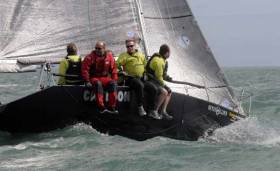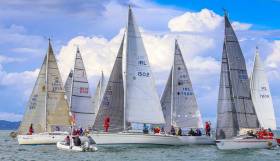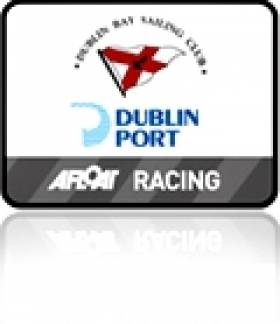Displaying items by tag: Cruisers 3
Following a light–air Cruisers Three East Coast Championships DBSC feeder race from Dun Laoghaire to Greystones on Saturday, the second two races of the 2017 Championship were held on Sunday in 20–knots of wind as part of the Greystones Harbour Regatta.
IRC
1st Quest (Barry Cunningham)
2nd Cartoon (Ken Lawless and Syb McCormack)
3rd Hard on Port (Flor O'Driscoll)
ECHO
1st Quest (Barry Cunningham)
2nd Cartoon (Ken Lawless and Syb McCormack)
3rd Running Wild (Brendan Foley)
Winner of the team prize and Rianoir Trophy: Quest, Cartoon and Enigma from the Royal Irish Yacht Club
The East Coast Championship for Cruisers Three takes place this weekend with an 'innovative mix of racing' using the DBSC Saturday feeder race from Dun Laoghaire to Greystones and combining this race with two races on Sunday as part of the 'Taste of Greystones' Regatta.
Read the Greystones Regatta preview here.
NOR is available from Michael Ryan at [email protected]
Gung Ho Wins it in DBSC races
BENETEAU 31.7 - 1. Prospect (Chris Johnston), 2. Violet Flame (B.Murphy/L.Osbourne), 3. Thirty Something (Gerry Jones et al)
BENETEAU 31.7 Echo- 1. Violet Flame (B.Murphy/L.Osbourne), 2. Kernach (Eoin O'Driscoll), 3. Extremity (Paul D'Alton)
CRUISERS 0 Echo - 1. WOW (George Sisk), 2. Tsunami (Vincent Farrell)
CRUISERS 0 - 1. WOW (George Sisk), 2. Tsunami (Vincent Farrell)
CRUISERS 1 Echo - 1. Jetstream (Peter Redden), 2. Aztec 3 (Peter Beamish), 3. Something Else (J.Hall et al)
CRUISERS 1 - 1. Joker 11 (John Maybury), 2. Jetstream (Peter Redden), 3. Aztec 3 (Peter Beamish)
CRUISERS 2 Echo - 1. Bendemeer (Gerald Kinsella), 2. Cor Baby (Keith Kiernan et al), 3. Red Rhum (J Nicholson)
CRUISERS 2 - 1. Jawesome 11 (V.Kennedy/M.Dyke), 2. Bendemeer (Gerald Kinsella), 3. Red Rhum (J Nicholson)
CRUISERS 3 Echo - 1. Carrabeg (D.Martin/R.Deasy), 2. Saki (Paget McCormack et al), 3. Gung Ho (G & S O'Shea)
CRUISERS 3 - 1. Gung Ho (G & S O'Shea), 2. Asterix (J.Counihan/F.Meredith), 3. Supernova (K.Lawless et al)
CRUISERS 4 - 1. Rascal (K.Burke/S.Milner), 2. Maranda (Myles Kelly)
DRAGON Race 1- 1. Diva (R.Johnson/R.Goodbody), 2. Phantom (D.Williams/P.Bowring), 3. Susele (Michael Halpenny)
DRAGON Race 2- 1. Diva (R.Johnson/R.Goodbody), 2. Zinzan (Daniel O'Connor et al), 3. Phantom (D.Williams/P.Bowring)
DRAGON Race 3- 1. Diva (R.Johnson/R.Goodbody), 2. Zinzan (Daniel O'Connor et al), 3. Susele (Michael Halpenny)
FIREBALL Race 1- 1. Elevation (N.Colin/M.Casey), 2. Licence to Thrill (Louis Smyth)
FIREBALL Race 2- 1. Licence to Thrill (Louis Smyth), 2. Elevation (N.Colin/M.Casey)
FLYING FIFTEEN Race 1- 1. Kooigjug (K Dumpleton), 2. Hy5ive (D & S Gorman), 3. Gekko (S & P Nolan)
FLYING FIFTEEN Race 2- 1. Kooigjug (K Dumpleton), 2. Snow White (Frank Burgess), 3. Hy5ive (D & S Gorman)
GLEN - 1. Glenluce (D & R O'Connor), 2. Glenshesk (L.Faulkner et al), 3. Pterodactyl (R & D McCaffrey)
IDRA 14 FOOT Race 1- 1. Dunmoanin (Frank Hamilton), 2. Sapphire (Lorcan O'Sullivan), 3. Squalls (Stephen Harrison)
IDRA 14 FOOT Race 1- 1. Dunmoanin (Frank Hamilton), 2. Sapphire (Lorcan O'Sullivan)
RUFFIAN 23 - 1. Alias (D.Meeke/M.McCarthy), 2. Ruffles (Michael Cutliffe), 3. Ruff N Ready (Ann Kirwan et al)
SHIPMAN - 1. Jo Slim (J.Clarke et al), 2. Euphanzel lll (Louis McSherry et al), 3. Curraglas (John Masterson)
SIGMA 33 - 1. Rupert (R.Lovegrove/P.Varian), 2. White Mischief (Timothy Goodbody), 3. Gwili Two (D.Clarke/P.Maguire)
SQUIB Race 1- 1. Anemos (Pete & Ann Evans), 2. Femme Fatale (Joe O'Byrne), 3. Kookaburra (P & M Dee)
SQUIB Race 2- 1. Femme Fatale (Joe O'Byrne), 2. Nimble (Brian O'Hare), 3. Perfection (Jill Fleming)
WHITE SAIL CRUISERS Echo - 1. Finnegans Wake (T.Rowlands et al), 2. Coumeenole (Bill Kavanagh), 3. Calypso (Howard Knott)
WHITE SAIL CRUISERS - 1. Act Two (Michael O'Leary et al), 2. Calypso (Howard Knott), 3. Windshift (R O'Flynn et al)































































